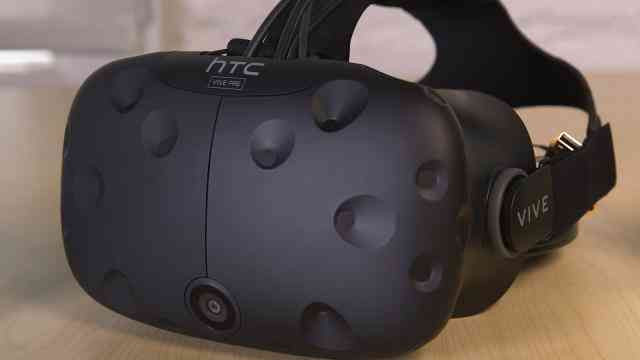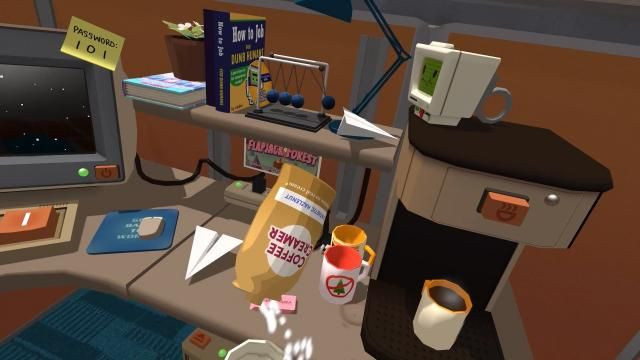HTC Vive Pre Hands-On: A Head-Slap Moment In The History Of VR

Virtual reality has finally delivered on its promise: You’re completely immersed in a game, oblivious to the outside world, totally at one with the virtual environment. Until, that is, you walk into a real-world wall. Or spill your drink. Or step on your cat’s tail. Suddenly, you’re scrambling to remove your VR headset and get back into actual reality. The spell is broken and you’re standing in a puddle of soda, nursing a bloody nose, or sticking your head under the couch and begging kitty to forgive you. And you didn’t even get to save your progress.
Unless you’re using the HTC Vive.
Forget everything you’ve heard about resolution, latency, content partnerships and processor requirements. The real news in virtual reality at this week's Consumer Electronics Show is the HTC Vive’s new front camera, which gives you the ability to interact with your physical environment without removing the headset. The feature represents something of a head-slap moment in the nascent VR industry; a feature that, once you’ve tried it, seems so obvious that you wonder why it wasn’t part of the base capabilities of every headset all along.
The functionality isn’t entirely new; some Oculus Rift prototype designs included front cameras, and the Totem, a long-delayed product from Canadian developer VRvana, is expected to include cameras when it becomes available (the company is now accepting pre-orders for a “mid-2016” ship date).
The Vive, however, is the first major VR headset to seamlessly blend virtual and physical in a way that feels entirely natural and unobtrusive. The capability is also a logical extension to the Vive’s “room-scale” VR, which, from the beginning, has relied on small sensors to define boundaries as a user wanders around a room. Earlier versions of the Vive added wall-detection capabilities, which automatically took you out of the game and dropped a grid in front of you if you got too close to the edge, much like the collision-warning features in some new cars, which set off an alarm if you get too close to another vehicle.
The new Vive — a nearly final developer edition dubbed the Vive Pre — builds on that capability. You still get an automatic warning if you’re about to hit a wall, but now you can see the actual wall, subtlety overlaid on your virtual environment.
At any time, a double-tap on a controller button brings up a real-world overlay on top of whatever you’re doing in the virtual space. While it might seem jarring to suddenly merge the virtual and the actual, HTC’s implementation makes it incredibly natural. You see blurred outlines of the real world, as if you’re emerging from a dream or have put on someone else’s glasses by mistake; it’s just enough to allow you to pick up your soda, sit down in a chair, or look your mom in the eye when she comes into the room, without feeling like you’ve been yanked out of your computer-generated space. HTC calls the real-world guidance “Chaperone,” an apt if somewhat patronizing way to describe a system designed to escort you from the virtual universe to the real one and back again.
According to HTC VP Dan O’Brien, room-scale VR and Chaperone were conceived at around the same time. “In thinking about VR, we said, we need to create the best possible experience,” he recalls. “And what is that experience? A lot of us think about the holodeck, of being in the middle of the content and the content is all around us. That’s where we started and that’s what we designed and built with Valve and Steam VR from the ground up.”
Working with Valve on the room-scale system, O’Brien says, the company “had to think about safety. We had to think of about a Chaperone system so that when you are moving around in room-scale, when you’re surrounded by your content, and interacting with your content, you need to feel safe. So, we have a Chaperone system, which accounts for your hard bounds. At the edge of your play space, it will invoke your Chaperone system and let you know when you’re getting too close to a hard bound or a wall.”

Beyond the camera and sensor technology, the Vive does about everything you’d expect a current-generation virtual reality headset to do. The demos at CES included theElite: Dangerous space adventure; Tilt Brush, Google’s VR take on Microsoft Paint (really, that’s what it feels like); theBlu: Encounter, an undersea environment featuring a giant whale; and Job Simulator, which lets you plug in a computer, answer the phone and make a cup of coffee. The virtual environments are immersive and do a good job of showing off the Vive’s room-scale capabilities; you can wander around the deck of a sunken ship or walk around and through your paintings to survey them from every angle, knowing that Chaperone will warn you if you’re about to hit a wall. The Vive’s twin controllers are responsive and have an intuitive layout, though seeing virtual representations of them within the VR environment can be a bit jarring, since — lacking a virtual representation of your hands — they appear to float in front of you.
Given that the HTC Vive won’t be released until later this year, and no price has yet to be announced, it’s hard to gauge its full capabilities, and whether it will be the platform to beat. Other VR systems, including the Oculus Rift (which is now available for pre-order at $599) and Sony’s PlayStation VR, are highly capable, and recent demos of those platforms have featured a wide variety of games, and a very compelling virtual experience. Neither platform currently includes Chaperone-like features, though it’s hard to imagine that Sony and Oculus aren’t seriously considering adding them (both systems are capable of room-scale VR, though neither supports it out of the box).
Room-scale VR still isn’t a perfect experience; you inevitably find yourself wanting a real open-world environment, and, inevitably, end up triggering Chaperone — or reaching the limits of the system’s wires — before you go too far. Still, the ability to move around your virtual space, even in a limited capacity, is a good first step toward the natural, holodeck-style environment described by HTC’s O’Brien. And, thanks to Chaperone, you can explore that environment without any major risks — other than the usual holodeck-addiction ones. Barclay, consider yourself warned.
© Copyright IBTimes 2024. All rights reserved.





















